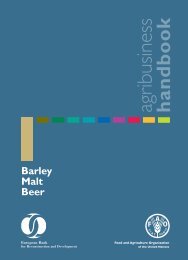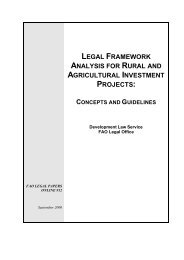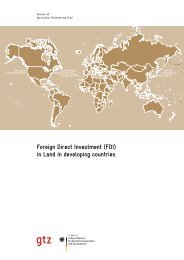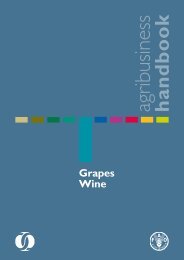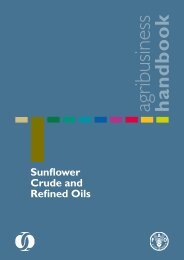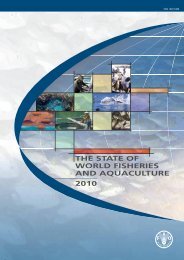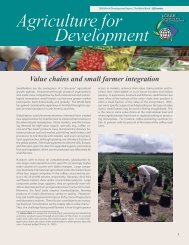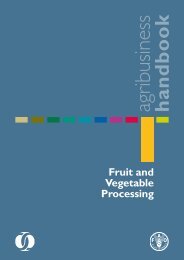Agribusiness Handbook: Milk / Dairy Products - FAO
Agribusiness Handbook: Milk / Dairy Products - FAO
Agribusiness Handbook: Milk / Dairy Products - FAO
You also want an ePaper? Increase the reach of your titles
YUMPU automatically turns print PDFs into web optimized ePapers that Google loves.
Figure 2: Cheese manufacturing process<br />
Raw milk<br />
Pasteurization<br />
Separation<br />
standardization<br />
Pre-pressing<br />
Curd<br />
manufacture<br />
Starter culture<br />
rennet<br />
Cheddaring<br />
Whey draining<br />
Moulding<br />
Milling<br />
Concentration<br />
Final pressing<br />
Salting<br />
Evaporation<br />
and drying<br />
Brining<br />
Final pressing<br />
Ripening<br />
Distribution<br />
Cheese composition varies greatly from product to product. Cheddar cheese<br />
normally has a milk-fat content of 50% a minimum in total solids and a maximum<br />
moisture content of 39%. Fresh cheeses may have a moisture content of 80%<br />
and fat contents in dry matter of just 5%. The product variety is endless.<br />
Most modern factories begin their manufacturing process by taking in raw<br />
milk, standardizing it to a specified solids content, pasteurizing it and then<br />
using it to manufacture dairy products. Many different processes and products<br />
are are possible in a modern factory to enable the production for example<br />
of either low-fat cheeses or cream cheese. Production standards for dairy<br />
products are tightly regulated to ensure the safety of public health and to<br />
guard against fraud. Typically, governments determine minimum product<br />
standards, covering hygiene and composition, that products must meet before<br />
they can be sold in the market. Commercial organizations also use product<br />
specifications to ensure that standards are met.<br />
19



